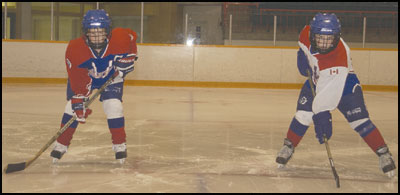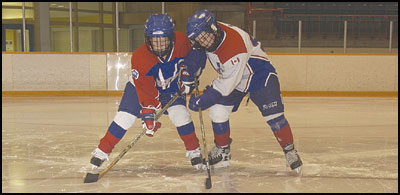Face
offs are one of the most common occurrences in a game of hockey. On the
surface, they seem simple enough. And yet, as is the case in this sport,
sometimes the simplest things are the most complex.
A
face-off shall take place when the Referee or Linesmen drops the puck on
the ice between the sticks of the players facing off. Not hard to
understand yet.
Now,
here is where everything begins to happen. The players taking the
face-off, usually the centerman from each team, is supposed to stand
squarely facing his opponent’s end of the rink. They are to stand about
one stick length apart with the full blade of their sticks flat on the
ice. All of the other players must be no closer than about 4.57 m (15
feet) from the face-off spot and they must be on-side (on the same side of
the ‘circle’ as their centerman).
When
the face-off takes place at any of the face-off spots in the end zones,
the centermen now have to stand squarely facing the other team’s end of
the rink and also clear of the face-off restraining lines which have been
drawn on the ice. They then must have their players taking part in the
face-off take their positions so that they will stand squarely facing
their opponents’ end of the rink, and clear of the face-off restraining
lines. The sticks of both players must be placed on the ice with the
toe of the blade touching within the designated white area. On top of
this, the visiting player must place his stick down first.
While
the centermen are getting ready for the puck to be dropped, all other
players must remain on-side. If any of them moves off-side, touches an
opponent, or moves inside the 15 foot circle, then the linesman is to
eject the centerman of the offending team and another player has to take
his place.
A
face-off is the only way a game can be started, and it is the only way
play can be resumed after a stoppage of play for any reason. It is
therefore, a very important part of hockey. It is also a very important
part of the game for coaches and players. Many goals result from winning
face-offs and there are players who practice endlessly to perfect their
face-off skills.
Fans
hate to see players tossed out of face-offs and they always yell at the
Linesmen to “Drop the puck!” The
delay in the game annoys fans because they want to see action, not players
getting kicked out of face-offs. However, the reason why players are
getting tossed out of face-offs is that one of the players on the
offending team is not obeying the rules of the face-off and thus they are
in essence cheating. A Linesman’s prime duty at each and every face-off
is to provide a fair face-off.
So
why do centremen get kicked out of face-offs?
One of the reasons is that the centreman himself is not obeying the
proper procedures of a face-off. The
centreman must come in square, using the two “L” lines to position
their feet and they are required to place their sticks flat on the ice and
only the tips of their blades are allowed to be in contact with the
face-off dot. When centremen come in crooked (feet not within the
constraints of the two “L” lines), or when the tips of their sticks
are not facing the other end boards, or when their sticks are not on the
ice, they may be tossed out of the circle to be replaced by another member
of their team.
The
most common reason for a centreman getting tossed out of a face-off is
that he is moving before the puck is actually out of the Linesman’s
hand. centremen like to get
the jump on the Linesman by placing their stick on the ice and then
immediately lifting their stick and moving it forward across the face-off
dot in an attempt to sweep the puck back between their legs.
This works if the Linesman actually drops the puck as the stick is
moving forward, because as the stick is coming back towards his body the
puck is already on the ice making it easy for this centreman to win the
draw.
When
centremen continue to put their sticks on the ice and then immediately
lift them they are likely to be tossed out of the face-off because it is
not fair to the other team’s centreman who has remained stationary as he
is supposed to. Another
popular reason why centreman will be tossed out of a face-off is because
they are moving into the face-off in an attempt to anticipate the Linesman
dropping the puck. If a centreman is moving at a face-off he will likely be
tossed because it is not only unfair to the other team but the Linesman
has a greater chance of being hit by this player as he skates through the
face-off dot.
The
centreman must come in square to a face-off with one foot on each side of
the “L” lines and he should be stationary (not moving) with the tip of
the stick pointing towards the opposite end of the rink and flat on the
ice. If this does not happen
then he will likely be tossed out of the face-off circle.
Granted, Linesman like to get the play going as quickly as possible
just like the fans, so they tend to give a little leeway with this rule.
Usually as long as the centreman has his stick on the ice and in
the white part of the face-off dot with his feet in the “L” lines and
moving slightly, he will drop the puck without throwing the centreman out
of the circle.
The
other reason why centemen get tossed out of the face-off has to deal with
his wingers who are usually trying to get a jump on their opponents by
anticipating when the Linesman will drop the puck.
First of all, the Linesman dropping the puck is responsible for the
two centremen and for the players located in front of him.
If one of these players jumps off-side then it is his duty to toss
the centreman. On almost
every face-off, there is usually a winger from each team located behind
the Linesman dropping the puck. It
is the duty of the other Linesman that is located on the opposite side of
the ice near the blue line to enforce the encroachment rule against these
players. This is why you will sometimes hear the whistle being blown by
the linesman at the blue line. He will then point to one end of the rink
to indicate which centerman should be tossed.
 |
The
players not taking the face-off must keep their bodies and their sticks
outside of the hash mark area. If
a player has his stick inside this area (this is very much like a no fly
zone, where you must stay out of this area) then he is considered to be
off-side and the centreman may be tossed out of the face-off. It
is legal though for the wingers at the face-off to have their sticks
inside the face-off circle as long as their sticks to not enter the hash
mark area. For this rule you
must imagine the hash marks extending right across the ice surface.
It would look silly if the lines of the hash marks were actually
drawn across the ice, so they are not.
|
| If
a player jumps the gun, so to speak, and enters into the end zone face-off
circle before the puck is dropped, then the centreman will be tossed out. If a winger from each team that is lined up across from each
other jumps the gun at the same time, the Linesman are instructed to send
a message to the teams and kick out only one centreman. They try to toss the centreman who’s winger jumped slightly
first. If they cannot
determine who moved first, it is usually the attaching team’s center who
is tossed. The reason for this is simply because of the fact that an
end-zone face-off is very important for the defending team to win in order
to prevent a goal. This is why you seldom see the defending team’s
centerman tossed unless the linesman is certain that is was his player who
moved first.
|
 |
| |
|
Sometimes
you will see two centreman tossed but for the most part the Linesmen are
taught to only throw out one centreman at a time.
It sends a stronger message to the teams to stay on-side.
In
fact a penalty can be assessed to a team who has more than one centeman
tossed from a face-off during the same stoppage of play.
This is rarely called and it usually never gets to this point
because the Linesmen, as stated earlier, like to get the game going just
as much as the fans, so they will work extra hard to get the replacement
centreman to obey the rules of the face-off.
So,
once again, a very natural and repeated part of the game such as face-offs
becomes something that coaches, players and fans often take for granted.
Linesmen have a lot to deal with in order to make sure that face-offs are
conducted fairly and within the rules. The reason it looks so simple and
natural is understandable – the officials make sure everything comes
together and everyone abides by the rules. Otherwise, there would be chaos
and all kinds of problems would arise.
